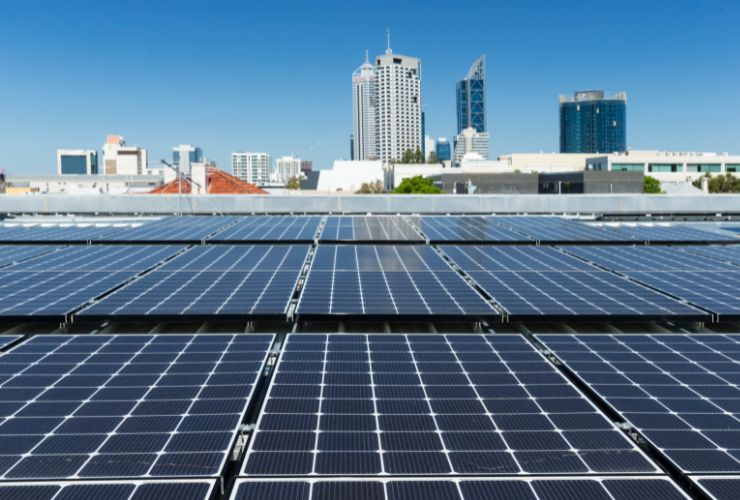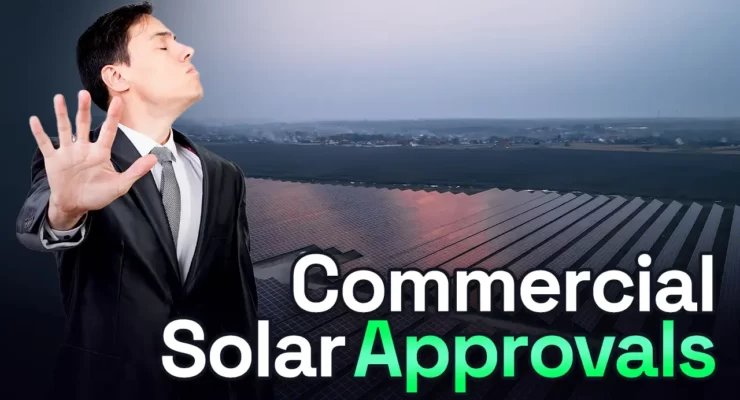Fast read
Before installing a commercial solar power system, businesses need to comply with various requirements and obtain approvals. These include development approval, building consent, and environmental assessment.
Network connection approval is also necessary, along with using Clean Energy Council-approved products and engaging certified system designers and solar installers. Larger systems may require registration as a power station.
Additionally, businesses must adhere to Australian Standards, electrical safety codes, and AEMO performance standards. Obtaining a certificate of electrical compliance, conducting a structural integrity assessment, and a roof safety assessment are crucial steps.
A work-at-height risk assessment is also essential. Compliance with these requirements is vital to avoid delays, fines, or system removal.
Compliances before installing a commercial solar system
As the world becomes more aware of the issues associated with climate change, businesses are looking at reducing and minimising their carbon footprint. A method in which companies are attempting to minimise their footprint is by purchasing and installing commercial solar systems.
If you’re planning to install commercial-size solar power systems on large roofs, you must consider several compliance requirements, standards, regulations, and approvals beforehand. Some of these requirements differ between States and Territories and between electricity distribution network service providers.
Complying with the following requirements is essential to avoid delays, fines, switching off, or even removal of the solar panel system.
Development approval, building consent, and environmental assessment for installing commercial solar systems
These approvals are essential to ensure that the project complies with local zoning laws, building codes, and environmental regulations. The process may require detailed site plans, environmental impact assessments, and consultation with local authorities. By demonstrating that the solar energy system will not negatively impact the community or environment, you will need to obtain the necessary permissions to proceed.
Network connection approval
Connecting your commercial solar PV system to the grid necessitates approval from the local utility company or grid operator. This step guarantees that your system’s integration with the grid is safe and adheres to performance standards. Often, this stage involves technical assessments and may necessitate alterations to the system design to meet the utility’s specifications.
Moreover, obtaining approval from the local utility company or grid operator is a critical step in ensuring the smooth and safe operation of your commercial solar PV system. By adhering to their requirements, you can ensure that your system functions efficiently and effectively while contributing clean energy to the grid.
Only use Clean Energy Council- (CEC) approved products
Selecting products approved by the Clean Energy Council ensures they meet Australian standards for safety and performance. Utilising CEC-approved products can give you access to government rebates, as non-approved components will simply not qualify. These approvals will also guarantee that the large-scale commercial PV system will function efficiently and safely.
Appropriate certification of system designer and installer
Hiring certified designers and installers is essential for ensuring that the solar system meets all regulatory standards. Certified professionals have demonstrated knowledge and expertise in designing and installing commercial solar systems, ensuring a high-quality project that complies with Australian standards.
Registration as a power station for larger commercial systems
For larger commercial solar systems, registering as a power station might be required. This means there are extra rules and oversight to follow because these systems are bigger and can have a bigger effect on the power grid.
This process involves making sure that the commercial solar system meets all the necessary regulations and standards. It’s important because larger systems can have a bigger impact on how energy generation and distribution function. By going through this registration process, we can ensure that we handle everything properly and that the solar system operates safely and efficiently within the power grid.

Compliance with various Australian Standards when installing commercial solar systems
Ensuring that the solar system meets national and regional standards is important for both safety and performance. This means following specific rules and guidelines that cover everything from how the system is designed to how it’s installed and operated.
These standards are in place to ensure that the commercial solar system operates smoothly and is safe for all users. They encompass detailed technical guidelines covering every aspect of the solar system, thereby guaranteeing its reliability and minimising potential issues.
Furthermore, by complying with these standards, we can have confidence that the solar system will fulfil its function properly and safely, providing clean energy without any worries.
Compliance with electrical safety codes
Meeting electrical safety codes is incredibly important to keep workers and the public safe. This involves making sure that things like grounding, circuit protection, and other safety measures are done correctly.
When we follow these codes, we can be sure that the solar system won’t cause any electrical accidents. It’s all about making sure that everything is set up properly and working safely, so everyone can use the solar system without any worries.
AEMO performance standards
Compliance with the Australian Energy Market Operator (AEMO) standards ensures that the system’s performance aligns with the broader energy market’s needs and regulations. These standards may include frequency control, voltage regulation, and other technical requirements.
Certificate of electrical compliance
Getting this certificate means having a licensed electrician or inspector come and check that the installation meets all the important electrical standards and codes. It’s a way of making sure that the system is set up the right way and is safe to use.
This step is crucial because it ensures that we do everything correctly, avoiding any potential electrical problems in the future. By obtaining this certificate, we can confirm that we’ve installed the solar system properly and that it’s safe for everyone to use.
Structural integrity certificate
This certificate confirms that the structures holding up the solar panels, whether they’re on the roof or ground mounts, are sturdy enough to handle the weight. Sometimes, an engineer has to check the site to make sure it can safely support the solar system for as long as it’s in use.
This is important because we want to make sure that the structures won’t give out under the weight of the solar panels. By getting this certificate, we can be confident that everything is strong and secure, and that the solar system will stay in place for years to come.
Roof safety assessment
When installing commercial solar systems, it’s important to check if the roof can handle the weight and if the installation process is safe. This safety check looks at things like how workers will get onto the roof and how they’ll stay safe while working up high.
First, we look at the roof to make sure it can support the extra weight of the solar panels without causing any damage. Next, we make sure workers can get onto the roof safely and have everything they need up there. This means checking for safe pathways and making sure any potential dangers are taken care of.
During the installation, we keep an eye on safety to make sure everyone stays safe. This might include using things like guardrails or safety harnesses to prevent falls.
Work at Heights risk assessment when installing commercial solar systems
Installing commercial solar systems often involves working at heights. This step entails assessing the risks and implementing measures to protect workers. This may include using specialized equipment, implementing safety procedures, and ensuring that all workers have the necessary training and certifications.
Furthermore, each of these steps plays a crucial role in ensuring that commercial solar system designers, installers, and operators prioritize safety, efficiency, and compliance with all relevant regulations and standards.
Moreover, some of these approvals and processes involve fees or require the expertise of specialists. Additionally, it’s essential to understand that the approvals required for your solar system depend on your location and the system’s size.



